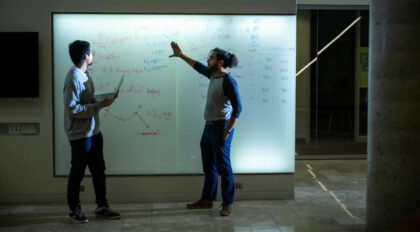Breaking down complex questions with the simple, yet powerful fruit fly
Entering tiny Knox College as a freshman, Odette Herrand thought of biology in terms of medical school.
That’s understandable because their mother and father practiced medicine in the Dominican Republic, where Herrand grew up. And Herrand watched as some of their older half-siblings became doctors.
“I saw them going through the studying, the rotations, the hardships that medical students go through,” Herrand says. “I always thought that biology meant medicine, and that wasn’t for me.”
But, during their freshman year at the 1,300-student liberal arts school in Illinois, Herrand took an engaging class in cell biology and physiology and was hooked. As Herrand took more undergraduate classes, the world of research unfolded before them.

“I stumbled into research and didn’t know that was something I could do as a career. I always thought of a scientist as someone you dressed up as at Halloween,” Herrand says. “I was fascinated that I could sit in a lab, ask a question and then make something happen to answer it.”
After doing undergraduate research on jaw morphology and temporomandibular disorders in mammals, Herrand joined the laboratory of Morgridge investigator and University of Wisconsin–Madison genetics professor Daniela Drummond-Barbosa as a research specialist.
The Drummond-Barbosa Lab is interested in fundamental questions about how tissues develop from stem cells, how fertility is controlled, and how the physiology of an organism connects to the reproduction. In particular, scientists there are studying the strong correlation between diets and other factors and infertility.
“I have my own project, where we’re trying to understand how yeast, which helps flies lay a lot of eggs, upregulates their egg lay,” says Herrand. “We want to understand what about yeast is helping them do that.”
That involves creating different yeast mutants to gauge their effect on egg production in fruit flies, a powerful model.
Another aspect that draws Herrand to science is its inherent creativity.
“You have so many ways of answering a single question, but there are limitations on the ways you can do that,” they say. “And that’s where the puzzle aspect and the challenge come in.”
From their days as an undergraduate teaching assistant in anatomy, Herrand also enjoys watching students grasp new concepts.
“I think it’s very gratifying to see somebody understand something because you broke it down to them,” they say. “Maybe it’s a little selfish to think you had something to do with that, but it’s very rewarding.”
At first, Herrand was cautious about jumping into a Ph.D. program.
“Everyone says you marry into a Ph.D., and that sounds pretty scary,” they say. “I wanted to see research up-close and get a feel for it at this level. I was here for a month, and I knew this was what I wanted to do.”
Herrand plans to apply for a doctoral program next year, possibly focusing on evolution and environmental biology.
“I’m 23. There’s so much to learn, and genetics is a new field for me. I just feel great that I can learn from all of these people.”

Rising Sparks: Early Career Stars
Rising Sparks is a monthly profile series exploring the personal inspirations and professional goals of early-career scientists at the Morgridge Institute.
